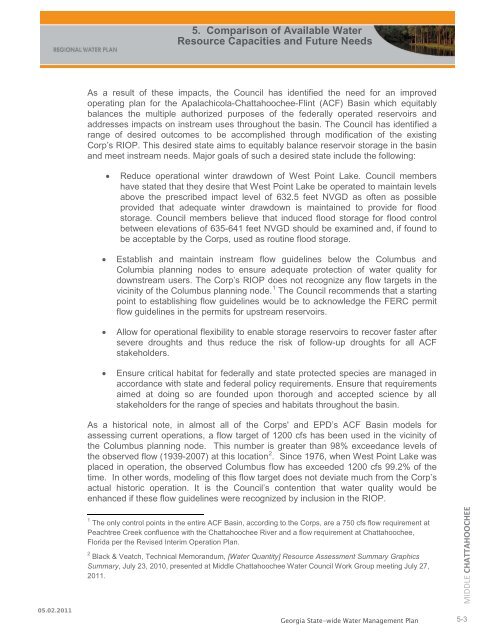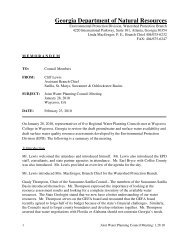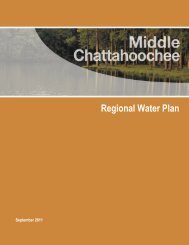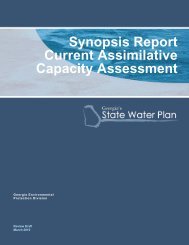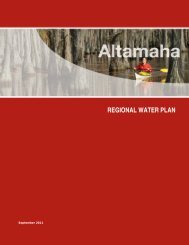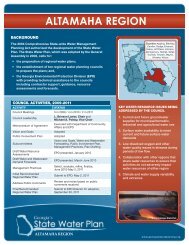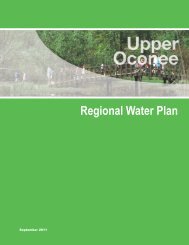Middle Chattahoochee Middle Chattahoochee
Middle Chattahoochee Middle Chattahoochee
Middle Chattahoochee Middle Chattahoochee
- No tags were found...
You also want an ePaper? Increase the reach of your titles
YUMPU automatically turns print PDFs into web optimized ePapers that Google loves.
5. Comparison of Available WaterResource Capacities and Future NeedsAs a result of these impacts, the Council has identified the need for an improvedoperating plan for the Apalachicola-<strong>Chattahoochee</strong>-Flint (ACF) Basin which equitablybalances the multiple authorized purposes of the federally operated reservoirs andaddresses impacts on instream uses throughout the basin. The Council has identified arange of desired outcomes to be accomplished through modification of the existingCorp’s RIOP. This desired state aims to equitably balance reservoir storage in the basinand meet instream needs. Major goals of such a desired state include the following:• Reduce operational winter drawdown of West Point Lake. Council membershave stated that they desire that West Point Lake be operated to maintain levelsabove the prescribed impact level of 632.5 feet NVGD as often as possibleprovided that adequate winter drawdown is maintained to provide for floodstorage. Council members believe that induced flood storage for flood controlbetween elevations of 635-641 feet NVGD should be examined and, if found tobe acceptable by the Corps, used as routine flood storage.• Establish and maintain instream flow guidelines below the Columbus andColumbia planning nodes to ensure adequate protection of water quality fordownstream users. The Corp’s RIOP does not recognize any flow targets in thevicinity of the Columbus planning node. 1 The Council recommends that a startingpoint to establishing flow guidelines would be to acknowledge the FERC permitflow guidelines in the permits for upstream reservoirs.• Allow for operational flexibility to enable storage reservoirs to recover faster aftersevere droughts and thus reduce the risk of follow-up droughts for all ACFstakeholders.• Ensure critical habitat for federally and state protected species are managed inaccordance with state and federal policy requirements. Ensure that requirementsaimed at doing so are founded upon thorough and accepted science by allstakeholders for the range of species and habitats throughout the basin.As a historical note, in almost all of the Corps' and EPD’s ACF Basin models forassessing current operations, a flow target of 1200 cfs has been used in the vicinity ofthe Columbus planning node. This number is greater than 98% exceedance levels ofthe observed flow (1939-2007) at this location 2 . Since 1976, when West Point Lake wasplaced in operation, the observed Columbus flow has exceeded 1200 cfs 99.2% of thetime. In other words, modeling of this flow target does not deviate much from the Corp’sactual historic operation. It is the Council’s contention that water quality would beenhanced if these flow guidelines were recognized by inclusion in the RIOP.05.02.20111 The only control points in the entire ACF Basin, according to the Corps, are a 750 cfs flow requirement atPeachtree Creek confluence with the <strong>Chattahoochee</strong> River and a flow requirement at <strong>Chattahoochee</strong>,Florida per the Revised Interim Operation Plan.2 Black & Veatch, Technical Memorandum, [Water Quantity] Resource Assessment Summary GraphicsSummary, July 23, 2010, presented at <strong>Middle</strong> <strong>Chattahoochee</strong> Water Council Work Group meeting July 27,2011.Georgia State-wide Water Management Plan 5-3MIDDLE CHATTAHOOCHEE


